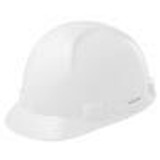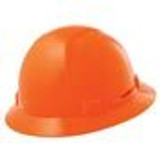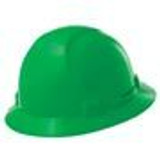
Hard Hat Safety Standards
Protective hard hats and helmets are described by impact type and electrical class. All protective hard hats and helmets shall meet either Type I or Type II requirements. All hard hats and helmets shall be further classified as meeting Class G, Class E, or Class C electrical requirements. Hard hats and helmets meeting the reverse wearing testing requirements shall be marked with the reverse wearing mark.
-
Customizablefor Pyramex SL Series Cap Style Hard Hat 4-Point Ratchet Suspension
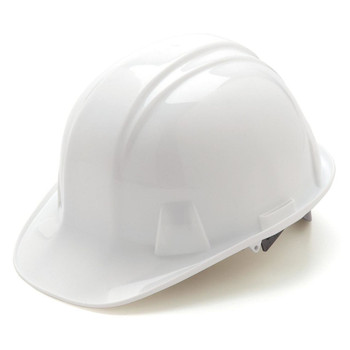
Pyramex SL Series Cap Style Hard Hat 4-Point Ratchet Suspension
Pyramex
$6.69 - $10.19Need your company logo on this hard hat? The Pyramex 4-Point Ratchet Suspension Hard Hat is constructed from high density polyethylene materials for a durable, long lasting product. The low profile design sits perfectly on the head. Each hat...$6.69 - $10.19 -
Customizablefor Pyramex Ridgeline Vented Full Brim Hard Hat 4-Point Ratchet Suspension - HP54117V - Black Graphite

Pyramex Ridgeline Vented Full Brim Hard Hat 4-Point Ratchet Suspension - HP54117V - Black Graphite
Pyramex
$31.19Need your company logo? The Pyramex Ridgeline Graphite Full Brim Vented 4-Point Ratchet Hard Hat - HP54117V features a shell constructed from high density polyethylene materials. Each hard hat is equipped with a ratchet suspension that is easy to...$31.19 -
Customizablefor Pyramex Ridgeline Vented Full Brim Hard Hat 4-Point Ratchet Suspension

Pyramex Ridgeline Vented Full Brim Hard Hat 4-Point Ratchet Suspension
Pyramex
$14.79 - $15.79Need your company logo? The Pyramex Ridgeline Full Brim Vented 4-Point Hard Hat - HP541V is made of ABS materials and features a 4-point ratchet suspension that is easy to adjust and allows the wearer to modify the fit while wearing. Each hard hat...$14.79 - $15.79 -
Customizablefor Pyramex Ridgeline Vented Cap Style Hard Hat 4-Point Ratchet Suspension

Pyramex Ridgeline Vented Cap Style Hard Hat 4-Point Ratchet Suspension
Pyramex
$11.99 - $12.89Need your company logo? The Pyramex Ridgeline 4-Point Vented Ratchet Hard Hat is made of ABS material and provides a low profile design. With swinging hinge points and 4-position harness points it provides comfort and flexibility. The Ridgeline also...$11.99 - $12.89 -
Customizablefor Pyramex Ridgeline XR7 Safety Helmet Hard Hat

Pyramex Ridgeline XR7 Safety Helmet Hard Hat
Pyramex
$67.19 - $76.69Need your company logo on this hard hat? The Pyramex Ridgeline XR7 is the helmet you've been looking for! Made from an ABS/PC blend that offers superior strength and higher heat resistance to competitors, plus a 6-point ratchet suspension with the...$67.19 - $76.69 -
Customizablefor Pyramex Ridgeline Full Brim Hard Hat 4-Point Ratchet Suspension

Pyramex Ridgeline Full Brim Hard Hat 4-Point Ratchet Suspension
Pyramex
$14.39 - $30.69Need your company logo? The Pyramex Ridgeline Full Brim Hard Hat - HP541 is made of ABS materials and features a 4-point ratchet suspension that is easy to adjust and allows the wearer to modify the fit while wearing. Each hard hat features a unique...$14.39 - $30.69 -
Customizablefor Pyramex Ridgeline Full Brim Hard Hat 4-Point Ratchet Suspension - HP54116 - Matte White Graphite
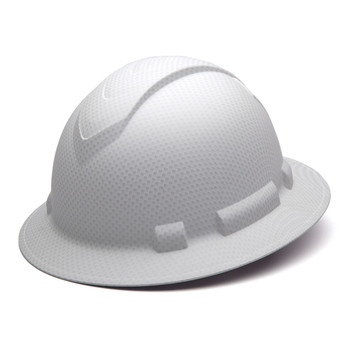
Pyramex Ridgeline Full Brim Hard Hat 4-Point Ratchet Suspension - HP54116 - Matte White Graphite
Pyramex
$30.69Need your company logo? The Pyramex Ridgeline Matte White Graphite Full Brim 4-Point Ratchet Hard Hat - HP54116 features a shell constructed ABS material that is strong, yet ultra-lightweight for seemingly weightless protection. The ratchet...$30.69 -
Customizablefor LIFT RADIX Type 2 Vented Safety Helmet

LIFT RADIX Type 2 Vented Safety Helmet
LIFT Safety
$104.99Need your company logo on this hard hat? The LIFT RADIX Vented Safety Helmet is comfortable thanks to its four-point LUX Suspension system, which guarantees the helmet will fit securely on the head. The magnetic quick-lock, adjustable chinstrap...$104.99 -
Customizablefor LIFT DAX Black Camo Carbon Fiber Full Brim Hard Hat - HDC-20CK

LIFT DAX Black Camo Carbon Fiber Full Brim Hard Hat - HDC-20CK
LIFT Safety
$175.40Need your company logo on this hard hat? The LIFT DAX FIFTY50 Carbon Fiber Hard Hat is a full brim, carbon fiber reinforced resin hard hat offering a 6 point suspension system for superior comfort and impact protection. It features an innovative...$175.40 -
Customizablefor Pyramex Ridgeline Cap Style Hard Hat 4-Point Ratchet Suspension

Pyramex Ridgeline Cap Style Hard Hat 4-Point Ratchet Suspension
Pyramex
$11.49 - $12.39Need your company logo? The Pyramex Ridgeline 4-Point Ratchet Hard Hat is made of strong, yet ultra lightweight ABS material for seemingly weightless protection. The low profile design offers a low center of gravity for better balance. There is a...$11.49 - $12.39 -
Customizablefor LIFT DAX Carbon Fiber Full Brim FIFTY/50 Hard Hat

LIFT DAX Carbon Fiber Full Brim FIFTY/50 Hard Hat
LIFT Safety
$175.40Need your company logo on this hard hat? The LIFT DAX FIFTY50 Carbon Fiber Hard Hat is a full brim, carbon fiber reinforced resin hard hat offering a 6 point suspension system for superior comfort and impact protection. It features an innovative...$175.40 -
Customizablefor Pyramex Ridgeline Cap Style Hard Hat 6-Point Ratchet Suspension
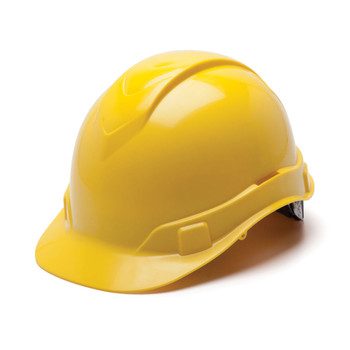
Pyramex Ridgeline Cap Style Hard Hat 6-Point Ratchet Suspension
Pyramex
$11.99 - $12.89Need your company logo? The Pyramex Ridgeline 6-Point Ratchet Hard Hat is made of strong, yet ultra lightweight ABS material for seemingly weightless protection. The low profile design offers a low center of gravity for better balance. There is a...$11.99 - $12.89
American National Standards (ANSI) and the International Safety Equipment Association (ISEA), in accordance with the most current ANSI/ISEA Z89.1-standards.
- Performance Requirements
- 7.1 Requirements for Type I and Type II Helmets
- 7.1.1 Flammability
- Helmets shall be tested in accordance with Section 9.1 anywhere above the STL. No flame shall be visible 5 seconds after removal of the test flame.
- 7.1.2 Force Transmission
- Helmets shall be tested in accordance with Section 9.2 and shall not transmit a force to the test headform that exceeds 4450 N (1000 lb). Additionally, for each test condition specified, the maximum transmitted force of individual test samples shall be averaged. The averaged values shall not exceed 3780 N (850 lb).
- 7.1.3 Apex Penetration
- Helmets shall be tested in accordance with Section 9.3. The penetrator shall not make contact with the top of the test headform.
- 7.1.4 Electrical Insulation Requirements
- Class G and Class E helmets shall meet their appropriate performance requirement as dtsted below. Class C helmets are not tested for electrical insulation.
- 7.1.4.1 Class G Requirements
- Class G helmets shall be tested in accordance with Section 9.7 and shall withstand 2200 volts (root mean square), AC, 60 Hertz, for 1 minute. Leakage shall not exceed 3 mildtamperes.
- 7.1.4.2 Class E Requirements
- Each helmet that meets Class E requirements for electrical insulation shall first pass the force transmission test specified in Section 7.1.2. Class E helmets shall be tested in accordance with Section 9.7 and shall withstand 20,000 volts (root mean square), AC, 60 Hertz, for 3 minutes. Leakage shall not exceed 9 mildtamperes. At 30,000 volts, the test sample shall not burn through.
- 7.2 Additional Requirements for Type II Helmets
- 7.2.1 Impact Energy Attenuation
- Type II helmets shall be tested in accordance with Section 9.4 anywhere above the DTL. Acceleration shall be recorded. Maximum acceleration shall not exceed 150 Gs.
- 7.2.2 Off-center Penetration
- Type II helmets shall be tested in accordance with Section 9.5 anywhere above the DTL. For each condition specified, the penetrator shall not make contact with the test headform when struck anywhere above the DTL.
- 7.2.3 Chin Strap
- Chin straps shall be made of suitable material not less than 12.7 mm (0.50 in.) in width. Type II helmets which are provided with chin straps shall be tested for retention in accordance with Section 9.6. For each condition specified, the chin strap shall remain intact. The residual elongation of the strap shall not exceed 25 mm (1.0 in.).

